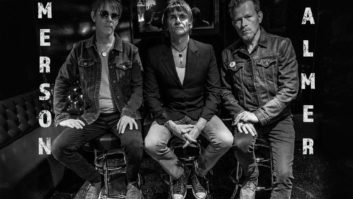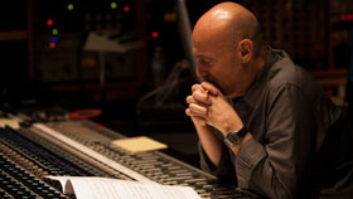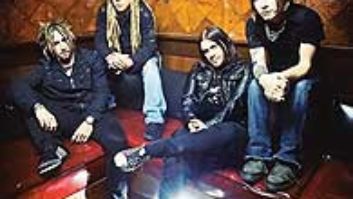
Approximately halfway through their 100-minute set, the lights go down and the members of Shinedown walk off stage. Through back pathways, the foursome makes their way to individual platform risers arranged in a diamond pattern out on the floor among the audience, with bassist Eric Bass to the right, guitarist Zach Myers to the left, drummer Barry Kerch at FOH and vocalist and Shinedown founder Brent Smith on the lawn.
The lights come back on, and they launch into “Amaryllis,” the title track from their fourth album, released in 2012. The four-song mini-set is a powerful and popular moment with the crowd, before the set then resumes on the main stage with a cover of Lynyrd Skynyrd’s “Simple Man.”
For front of house engineer Andy Meyer, the mini-set provides its own challenges, as Kerch’s riser is located right next to his mix position.
“Once the mix is solid, you just need to be able to work the nuances, so I just throw on headphones while he’s going at it 10 feet from my head,” laughs Meyer. “We put some plexi around three sides of it so the fans wouldn’t get hit too hard. They really love the gag, man. I mean, I tell you, to watch their faces and see how much fun everybody has with it, it’s really cool. You might want to ask me about the time difference? It’s there, all of us that understand it, it makes you crazy, but I don’t see one person going, ‘Oh, my God, the snare is out of time,’ you know? They don’t care. The super fan that’s right there, they’re just so thrilled to be right up next to it that I don’t think they even perceive it that way, to be honest.”
Meyer joined the Shinedown tour this summer after coming off a three-year stint working for Justin Timberlake. He has been working in live sound for four decades now, with some of his previous gigs including the Smithereens, Dada, Everlast, Pat Benatar, Widespread Panic, Rage Against the Machine and Guns N’ Roses, among others. “I’ve kind of bounced around from rock to pop,” Meyer says.

He started with Shinedown after a call from band members Myers and Smith. “Brent called me and we talked for a couple hours, just about people more than anything, how they treat people. Things you want to hear, like respect. After we talked, I thought, ‘You know, I haven’t done that type of tour in a really long time.’ Last time I did sheds was Mötley Crüe, and I thought, you know, this would be good.”
Meyer mixes at a DiGiSo SD7 with Shinedown, in part because of its snapshot capabilities, which he uses frequently in the set. While he appreciates the flexibility of digital consoles for snapshots and the high-input counts, he also likes an analog vibe.
“I use a lot of analog insert gear, so I’m still utilizing all the great advantages you have in the digital domain to be able to control those things, and then you still have that nice analog warmth. We’re using a lot of Rupert Neve gear, Shelford Channels, Portico Channels and a Portico Master Buss Processor, the 5059 and the 5060 summing consoles, 5045 enhancers, 5043 compressor-limiters, 5042 tape emulators, 511 pres, and the R10 chassis for those.
“Something I’d like to touch on, too, is for the conversion back to digital, I use Apogee Symphonys,” he continues. “I get all the analog into all the analog gear, summing everything, then I put analog into the Apogees and convert it back to digital with state-of-the-art converters. That’s the real trick, right? I clock everything with one clock so I can turn off all sample rate conversion. So now, when you insert a piece of analog gear, it actually improves it.”
D/A clocking is handled by Antelope Trinity and Antelope 10M units. Meyer also has a variety of Thermionic Culture gear at FOH, including the Phoenix Mastering Compressor, Swift Mastering EQ, Kite Mastering EQ, and Little Red Bustard. He also uses four Universal Audio Apollo MKIIs at FOH.
In addition to his appreciation of analog gear, another thing that sets Meyer apart is his rejection of room tuning the P.A. system, which on the Shinedown tour is a Clair Brothers system, utilizing Cohesion 12s on the main hang, Cohesions 10s for the side hang and CP-218 subs.
“All these new line arrays are excellent; there’s millions of dollars of R and D, and if it’s flown properly, timed properly, you put in a mastered CD of something you know sounds good, and it sounds great,” he explains. “A lot of the EQ you do live is fighting atmospherics. I utilize the mastering gear inserted on the master bus to clean all that up every day, so I just make little finite touches, and that’s all I ever do. I don’t EQ at all anymore. I just use my virtual playback, play a song from the night before, touch it up a little bit, and I’m good.”
Shinedown uses mostly sE microphones on stage. The vocal mics are all V7s. On the drums, he uses sE VKick mics on the toms. The snare top is an sE V7 X, and the snare bottom is an sE8 condenser. The overheads and ride are also sE8s. Shure Beta 91s face in opposite directions to get depth on the kick drum.
To get the instruments into the P.A., Meyer is using direct boxes, including the Rupert Neve Designs RNDI and a Universal Audio OX amptop attenuator box on guitars.
“I changed us over to Neve RNDIs; you can also use them in speaker mode,” he says. “For the bass rig, we run right out of the amplifier into an RNDI. We run the bass guitar dirty amp into a second RNDI and then right into the cabinet, as well. We’re pulling our source direct from the Neve DIs. They sound really natural, really fantastic.”

Chris Lightcap, meanwhile, is mixing monitors, as he has been with Shinedown for 12 years. Other artists he’s worked with include Anthony Hamilton, Staind, Nelly and New Kids on the Block. He got his start in sound as a teenager.
Like Meyer, Lightcap turned to DiGiCo for the console, using an SD5 along with two Waves servers and an Eventide Eclipse for some vocal effects. He started using the SD5 with Shinedown after using it with New Kids. While he uses the onboard gates and channel multiband compressors from the SD5, he relies on the Waves.
“I’d say about 70 percent of my Waves stuff is compression, just an SSL Buss Comp on everyone’s mix,” he explains. “I’m using the H-Reverb for vocal and drum verbs, and then the normal C6 on Brent’s vocal and some C4s on the acoustic guitars. Nothing really too wild.”
The band uses Shure PSM 1000s for wireless monitoring, and they all have JH Audio Roxanne custom in-ear earbuds.
“Everybody’s pretty much getting full mixes, with them on top a little,” explains Lightcap. “Zach likes a full, round mix, like a studio mix, but he likes to hear a lot of the room, so he gets the audience mics in his mix constantly. The other guys, I’ll ride the audience mics, but he hears a lot of the room, as well as the mix. He likes that vibe, if you will. For the other guys, it’s just kind of up between songs or certain parts, that crowd participation. Within the song itself, most of the time the audience mics are off for the other guys.”
For the diamond mini-set, Lightcap employs a secondary set of wireless transmitters.
“Because of the distance in some of these sheds, we opted to have a second set of transmitters at front of house for the ears—just to cut down on the distance—that were controlled via Shure’s Wireless Workbench. All the wireless stuff was networked together so I could mute or unmute transmitters for ears, turn off the set for the stage on their walk out there and then unmute the ones out in the house and then vice versa for them walking back.”





